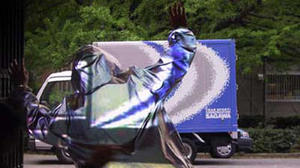Invisibility cloaksInvisibility cloaks are hiding around the corner
In 1897 H. G. Wells created a fictional scientist who became invisible by changing his refractive index to that of air, so that his body could not absorb or reflect light; more recently, Harry Potter disappeared from sight after wrapping himself in a cloak spun from the pelts of magical herbivores; now, a Michigan Technology University researcher has found ways to use magnetic resonance to capture rays of visible light and route them around objects, rendering those objects invisible to the human eye

The invisibility cloak may be close at hand // Source: howstuffworks.com
With NSF support, Elena Semouchkina and colleagues are experimenting with ways of using magnetic resonance to capture rays of visible light and route them around objects, rendering those objects invisible to the human eye
In 1897 H. G. Wells created a fictional scientist who became invisible by changing his refractive index to that of air, so that his body could not absorb or reflect light. More recently, Harry Potter disappeared from sight after wrapping himself in a cloak spun from the pelts of magical herbivores.
Countless other fictional characters in books and films throughout history have discovered or devised ways to become invisible, a theme that long has been a staple of science fiction and a source of endless fascination for humans. Who among us has never imagined the possibilities? It is not for real, however — or is it?
While no one yet has the power to put on a garment and disappear, Elena Semouchkina, an associate professor of electrical and computer engineering at Michigan Technological University, has found ways to use magnetic resonance to capture rays of visible light and route them around objects, rendering those objects invisible to the human eye. Her work is based on the transformation optics approaches, developed and applied to the solution of invisibility problems by British scientists John B. Pendry and Ulf Leonhardt in 2006.
“Imagine that you look at the object, which is placed in front of a light source,” she explains.
“The object would be invisible for your eye if the light rays are sent around the object to avoid scattering, and are accelerated along these curved paths to reach your eye undistinguishable from direct straight beams exiting the source, when the object is absent.”
At its simplest, the beams of light flow around the object and then meet again on the other side so that someone looking directly at the object would not be able to see it — but only what is on the other side.
“You would see the light source directly through the object,” said Semouchkina. “This effect could be achieved if we surround the object by a shell with a specific distribution of such material parameters as permittivity and permeability.”
She and her collaborators at the Pennsylvania State University, where she is also an adjunct professor, designed a nonmetallic “invisibility cloak” that uses concentric arrays of identical glass resonators made of chalcogenide glass, a type of dielectric material—that is, one that does not
